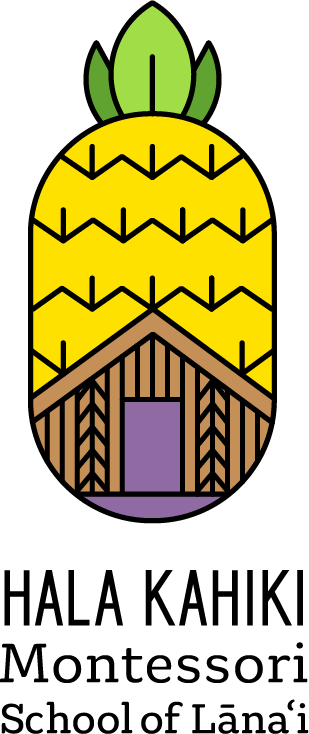At Hala Kahiki Montessori School of Lāna‘i, we follow the Montessori method - a unique and deeply respectful approach to early childhood education. But what does “Montessori” really mean, especially for children under the age of six?
Let’s take a closer look at this beautiful philosophy and how it guides what we do each day at HKMS - and how you can embrace it at home.
The Absorbent Mind: A Once-in-a-Lifetime Window
Maria Montessori described the child from birth to age six as having an "absorbent mind" - a mind that takes in everything from the environment effortlessly, like a sponge soaking up water. During these early years, children are not just learning facts; they are building their minds, their language, their movement, their sense of self, and their understanding of how the world works.
This absorbent mind is most powerful in the first six years of life. It’s why your young child starts using new words seemingly out of nowhere, or your preschooler mimics your routines down to the smallest detail. Children at this age learn through observation, repetition, movement, and meaningful connection.

What We Do at School
At HKMS, everything we do is built around honoring this sensitive and powerful stage of development. Some key ways we support the absorbent mind:
1. A Prepared Environment
We create calm, beautiful spaces that are just the right size and scale for young children. Everything has a place. Materials are thoughtfully chosen and presented to match the child’s stage of development. When a child walks into our classroom, they know this space is meant for them.
2. Freedom Within Limits
Children choose their work based on interest, which builds independence and self-motivation. But this freedom happens within gentle, clear boundaries. We guide children to care for materials, respect others, and complete their cycles of work.
3. Practical Life Activities
Pouring water, slicing bananas, sweeping the floor - these everyday tasks are beloved in the Montessori environment. They help children develop coordination, concentration, and a deep sense of belonging.
4. Hands-On Learning
Whether working with puzzle maps, sandpaper letters, or knobbed cylinders, Montessori materials are hands-on, purposeful, and designed to lead the child toward discovery. The goal isn’t to “teach” - it’s to invite the child to learn.
5. Mixed-Age Classrooms
Children ages 1–3 or 3–6 learn alongside one another. The younger children are inspired by the older ones, while the older ones gain confidence and leadership through modeling and helping.

Embracing the Mess (and the Beauty in Imperfection)
Montessori is often described as peaceful and orderly - but it’s also joyfully messy. In our classrooms, you’ll find tiny spills, crooked flower arrangements, and bananas cut into wild shapes. And that’s the point. We honor the process over the product. The child is learning to pour, not to pour perfectly. They're painting to express themselves, not to create something "pretty." We know that real growth happens through trial, error, and repetition. Mistakes aren’t failures - they’re essential steps in learning. By giving children the space to do things for themselves, even if it’s not “just right,” we nurture their confidence, resilience, and sense of pride in their own efforts.

Bringing Montessori Home: Simple, Powerful Practices
You don’t need shelves of wooden materials or a perfect routine to bring Montessori home. The most important things are your presence, respect, and trust in your child’s natural development. Here are a few ways to start:
- Slow down. Give your child time to try things on their own. Let them dress themselves, pour their own milk, or help with cooking - even if it’s not perfect.
- Invite, don’t command. Use language like “Would you like to help me fold the towels?” instead of “You need to fold these.”
- Create order. Keep toys and materials on low shelves, in baskets, and accessible. Less is more - rotate toys so your child isn’t overwhelmed.
- Model calm and respect. Speak to your child the way you’d like to be spoken to. Pause. Kneel down to their level. Listen deeply.
- Protect concentration. If your child is engaged in something - stacking blocks, stirring batter, watering a plant - try not to interrupt. This focused attention is how they learn.

A Community of Growth
Here on Lāna‘i, we are so fortunate to be raising children in a close-knit, nature-filled, and culturally rich environment. Montessori honors the natural rhythms of children and allows them to grow in confidence, independence, and compassion.
We are grateful to partner with you in this journey. Together, let’s nurture these early years with intention, trust, and wonder.
To Learn More
The Montessori Philosophy
Fast Facts: What is Montessori?
The Montessori Method, Dr. Maria Montessori
About Hala Kahiki
Designed for children 18 months – 6 years, Hala Kahiki is the first and only authentic Montessori school on Lāna’i. Under the guiding influence of specially trained teachers, children work with multi-sensorial materials to help them learn to think critically and become well-rounded global citizens. We would love to partner with you to give your children the best-possible early childhood education; please let us know how we can help you achieve your goals for your child.




